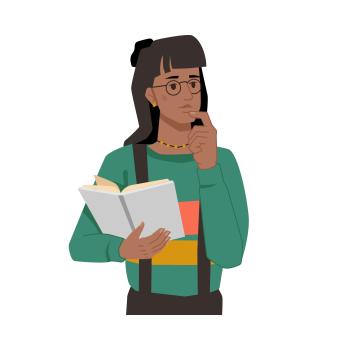Word Maps: Developing Critical and Analytical Thinking About Literary Characters

- Preview |
- Standards |
- Resources & Preparation |
- Instructional Plan |
- Related Resources |
- Comments
Overview
Word maps can help students represent and analyze the various feelings, thoughts, and actions of a character in a story. In this lesson, students read the short story "After Twenty Years" by O. Henry and focus on the two main characters in the story. With the use of a word map, they identify the characters' qualities or traits based on their actions. They discuss the characters' feelings and actions, reflecting upon these in their journals and making connections to their own lives.
Featured Resources
Literary Elements Map: Students will use this interactive tool to analyze the characters and the story.
From Theory to Practice
- In this article, the author gives a clear example of how students can make personal connections with a text by identifying with the characters in a story.
- Students often have a better understanding of characters in a story when they find that the characters have "the same personality traits as themselves and people in their own lives." (431)
- Word maps can help activate prior knowledge of a topic and thereby prepare students to better understand the characters in a story.
Common Core Standards
This resource has been aligned to the Common Core State Standards for states in which they have been adopted. If a state does not appear in the drop-down, CCSS alignments are forthcoming.
State Standards
This lesson has been aligned to standards in the following states. If a state does not appear in the drop-down, standard alignments are not currently available for that state.
NCTE/IRA National Standards for the English Language Arts
- 3. Students apply a wide range of strategies to comprehend, interpret, evaluate, and appreciate texts. They draw on their prior experience, their interactions with other readers and writers, their knowledge of word meaning and of other texts, their word identification strategies, and their understanding of textual features (e.g., sound-letter correspondence, sentence structure, context, graphics).
- 6. Students apply knowledge of language structure, language conventions (e.g., spelling and punctuation), media techniques, figurative language, and genre to create, critique, and discuss print and nonprint texts.
- 11. Students participate as knowledgeable, reflective, creative, and critical members of a variety of literacy communities.
- 12. Students use spoken, written, and visual language to accomplish their own purposes (e.g., for learning, enjoyment, persuasion, and the exchange of information).
Materials and Technology
Printouts
Websites
Preparation
| 1. | This lesson uses the short story "After Twenty Years" by O. Henry to introduce students to the comprehension strategy of characterization.
Story synopsis: |
| 2. | Divide the story into two parts, the first part ending with the line, "It's an appointment made twenty years ago." The remainder of the story will be used as the second part (see the Instructional Plan, Sessions 1 and 2). |
| 3. | Prepare overhead transparencies with journal questions or be prepared to write questions on the board for student response. (See Sessions 1 and 2 and the Student Assessment/Reflections section for possible questions.) |
| 4. | Preview the Literary Elements Map so that you will be able to demonstrate how to use the tool before students work in their groups. |
| 5. | Preview Bridging the Gap: Group Work Rubrics and Checklist or RubiStar to access or create assessment rubrics for this lesson. |
Student Objectives
Students will
- Use a word map as a strategy for better understanding the characters in a story
- Analyze the many aspects of a character's life, problems, situations, feelings, and actions, and make connections to their own lives and to the world
- Construct a better understanding of themselves by exploring and communicating their views and opinions about the characters in a text
- Participate as knowledgeable, reflective, creative, and critical persons in respectful dialogue with one another during class discussions and while working in cooperative groups
Session 1
| 1. | Students will begin this session by creating a word map that characterizes "a good friend." The rationale for this activity is to activate prior knowledge and prepare students to read the story by relating to their own experiences and the people they know. |
| 2. | Divide students into groups of three to four students each. Explain to students that on the word map they will need to think about and record the actions, words, and feelings that characterize a good friend. Encourage students to reflect on their own personal friendships and to provide specific examples on the word map. |
| 3. | After brainstorming as a group, students may also find additional ideas by looking up the word "friend" or other related words in a dictionary or Merriam-Webster Online. |
| 4. | Ask students to choose one speaker from each group to share their word map with the class. |
| 5. | Display the word maps from each group in the classroom, as students will be required to refer back to them at the end of this session and also later in the lesson. |
| 6. | Distribute copies of the first part of the story "After Twenty Years" by O. Henry as explained in the Preparation section of this lesson. |
| 7. | Explain to students that they will be reading this short story in parts and that they will be using the interactive Literary Elements Map to analyze the characters and the story. (Note: This online tool provides a Character Map, Setting Map, Conflict Map, and Resolution Map. The Setting Map will not be used as part of this lesson.) |
| 8. | Ask students to read the first part of the story individually. |
| 9. | After reading, students can reconvene in their original groups to work on creating an online Character Map for each of the two characters in the story. At this point, they will be able to describe the policeman, but won't have much information about the second main character. For this reason, ask them to make predictions about the character. |
| 10. | In addition to completing and printing the Character Maps, ask students to think about words or actions from the story that they think are significant about these two characters and possible reasons for their actions. Have them record their ideas on the back of the Character Map printouts and save them for later use in Session 2. |
| 11. | In closing, ask students to answer the following journal questions in class if there is time or as homework.
|
Session 2
| 1. | Start this session with a class discussion on the journal questions assigned at the end of Session 1. This discussion will generate interest in how the story continues. |
||||||||
| 2. | Ask students to individually read the remainder of the story. |
||||||||
| 3. | Gather students in their original groups from Session 1, and ask them to review the two Character Maps they completed previously and to add any new information based on the second part of the story just read. |
||||||||
| 4. | Have each group also create an online Conflict Map and Resolution Map for the story. |
||||||||
| 5. | Ask each group to choose a speaker, and have all groups share their completed maps with the rest of the class. |
||||||||
| 6. | If there is time at the end of the session, students can respond to the following journal questions in class. If not, you can assign them for homework.
|
Session 3
| 1. | Begin this session by asking students to share their journal responses with the rest of the class. This activity will generate a lively class discussion about the story and the two characters. |
| 2. | Invite students as a whole class to think about whether the characters in the story fit the characteristics of a good friend, as described on their word maps completed during Session 1. As part of this discussion, encourage students to make connections to their own lives by sharing personal experiences they have had with their friends. |
| 3. | Have students work in their groups to prepare a three- to five-minute role-play in which they assume the roles of the two characters and narrator in the story. Challenge groups to decide whether they agree or disagree with O. Henry's version and the actions of the characters in the story. If they agree, they can act out the story in the same way as O. Henry tells it. If they disagree, they can change the characters' behaviors to show how they think the story should have been written. |
Session 4
End the lesson by having students perform their role-plays for the class. Ask for students' reactions to each group's depiction of the two characters, and lead a class discussion to talk about the different perspectives presented by students.
Extensions
- ReadWriteThink Printing Press. Have students create newspaper articles about the arrest of 'Silky' Bob. As part of their articles, students can include interviews with the two characters in the story to reflect characterization.
- Lights, Camera, Action: Interviewing a Book Character. Although this lesson is intended for grades 6-8, it can easily be modified for high school. Have students develop a television talk show that uses the characters from the story "After Twenty Years" as the acting characters on the show.
- Have students create Character Trading Cards for the characters in "After Twenty Years." They can then exchange cards to compare them or use them as a writing prompts for an essay about character development in the story.
Student Assessment / Reflections
- Ask students to reflect in their journals on what they have learned from this lesson and the story. You can leave the writing open or have students respond to one or more of the following prompts:
- What have you learned from this lesson?
- Have you enjoyed sharing your opinions and ideas with your classmates? Why or why not?
- Do you feel that connecting with the characters in the short story "After Twenty Years" helped you better understand the story?
- How did the use of graphic organizers (e.g., the word map, character map, conflict map, and resolution map) help you organize your ideas? Do you think they helped you to better understand the characters and the story?
- What have you learned from this lesson?
- To assess cooperative work skills and the completion of the word map and literary elements maps, access Bridging the Gap: Group Work Rubrics and Checklists or RubiStar to find or create assessment rubrics.
- Review students' journal responses to assess their ability to make personal connections to the story and their level of comprehension.

Add new comment